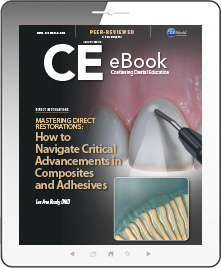Mastering Direct Restorations: How to Navigate Critical Advancements in Composites and Adhesives
Released: Thursday, July 12, 2018
Expires: Saturday, July 31, 2021
By Lee Ann Brady, DMD
Commercial Supporter: Kulzer
Dental restorative materials have seen significant changes over the years, including composites, flowables, bulk fills, adhesives, etch, and polish. Dentists can take advantage of these changes by thoroughly researching their products of choice and embracing how new properties create more-efficient case procedures. Considerations include whether composites fall into a nanofiller or nanohybrid category, what kind of bulk-fill regimen is preferred, and the properties of different adhesives. Overall, benefits when deploying these improved materials together include minimizing sensitivity, minimizing challenges in bonding, achieving lower postoperative sensitivity, and achieving greater longevity for restorations. The author concludes that all physical properties of dental materials have a direct influence on enhanced patient care. Therefore, it is essential to remain updated on advances related to appropriate use.
LEARNING OBJECTIVES:
-
Describe the critical physical properties of current restorative materials.
-
Assess the clinical conditions that preclude use of different types of composites, flowables, and other restorative materials.
-
Explain why advancements in materials have occurred as well as how they improve patient care.
Lee Ann Brady, DMD, is a privately practicing dentist and nationally recognized educator, lecturer, and author. She is currently Director of Education of the Pankey Institute. Dr. Brady has also developed a vast library of online instruction at leeannbrady.com and restorativenation.com. She practices in Glendale, Arizona, and is a member of the editorial board for the Journal of Cosmetic Dentistry, Inside Dentistry, and Dentaltown Magazine.
